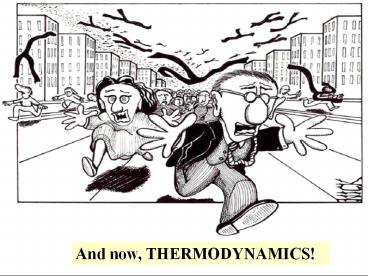Chapter 18: Granitoid Rocks - PowerPoint PPT Presentation
Title:
Chapter 18: Granitoid Rocks
Description:
And now, THERMODYNAMICS! – PowerPoint PPT presentation
Number of Views:66
Avg rating:3.0/5.0
Title: Chapter 18: Granitoid Rocks
1
And now, THERMODYNAMICS!
2
Thermodynamics need not be so hard if you think
of it as heat and chemical flow between
phases.
3
Derivation of Phase Rule
- Lets do a book-keeping exercise and
evaluate the number of minerals (phases) that can
co-exist in a chemical system under certain P,T
conditions. - (Derivation adapted from Prince, 1967,
Alloy Phase Equilibria)
4
The Gibbs Phase Rule
F C - P 2 F degrees of freedom, or..
The number of intensive parameters that must
be specified in order to completely determine
the system What does this MEAN?
5
The Phase Rule-P C
F C - P 2 P of phases phases are
mechanically separable constituents
C minimum of components (the of chemical
constituents that must be specified in order to
define all phases)
6
The Phase Rule-2
F C - P 2 2 the number of intensive
parameters Usually 2 for Temperature and
Pressure and this is especially useful for
geologists
7
Derivation of Phase Rule
- a balancing of
- FIXED PARAMETERS
- and
- SYSTEM VARIABLES
- ??which means?????
8
HOW MANY VARIABLES ARE THERE IN A CHEMICAL SYSTEM?
- Simplistically, 3,
- Pressure, Temperature, Composition,
- BUT, for more than one phase, what is the TOTAL
number of variables?
9
Assign C components between P phases
- For each Phase, composition is defined by (C-1)
concentration terms. - For ALL Phases in the system, P(C-1) the number
of concentration terms. - Can also vary Pressure Temperature, or P T,
which 2 more variables.
10
- Therefore,
- the TOTAL NUMBER OF VARIABLES
- P(C-1) 2
11
- NOW, LETS EXAMINE HOW MANY FACTORS EXIST THAT
FULLY DESCRIBE THE SYSTEM and ARE FIXED BY THE
SET FACTORS.
12
- Since the system is in equilibrium, BY
DEFINITION, we have already implicitly defined
some of the variables. - µ chemical potential or chemical flux or energy
between two minerals.
13
- So, if system is in equilibrium,
- and if there is NO NET CHANGE in the net
amounts of chemicals moving between phases
that are in dynamic equilibrium, - (e.g., NO NET MOVEMENT or CHEMICAL CHANGE,
PLUS OR MINUS BETWEEN PHASES), then
14
- Aµa Aµß Aµ?.. Aµ8
- Bµa Bµß Bµ?.. Bµ8
- Cµa Cµß Cµ?.. Cµ8
- The chemical potential or the chemical flux of
a given chemical must be the same in all phases
coexisting at equilibrium-No NET Change!
15
- So,
- Aµa Aµß Aµß Aµ8
- and, they yield
- Aµa Aµ8
- and then,
- TWO independent equations determine the
equilibrium between 3 phases for EACH Component.
16
- For EACH Component,
- there are
- (P-1) independent equations relating the
chemical potential, µ, of that component in ALL
of the Phases.
17
- For the GENERAL case of P phases and C
components, - There are
- C(P-1) independent equations.
- Thus, we FIX C(P-1) variables when we
stipulate that the system is in equilibrium.
18
- Now, the number of independent variables or the
total number of variations which can be made
independently - the total number of variables, less those that
are automatically fixed.
19
- F number of Freedom factors
- F P(C-1) 2 C(P-1)
- TOTAL AUTOMATICALLY
- FIXED
20
- The variance of a system or the Degrees of
Freedom - F C-P 2
- Which is called
- the Gibbs Phase Rule.
- For a dry system w/ no vapor,
- F C-P 1
21
The Goldschmidt Mineralogical Phase Rule
- What is the likelihood of being on a specific
reaction curve in P-T space or being in general
P-T space, where P T are variables?
22
The Phase Rule in Metamorphic Systems
- If F ? 2 (at least P T are variables) which
is the most common situation, then the phase rule
may be adjusted accordingly - F C - P 2, and P C
- P ? C which is Goldschmidts Mineralogical
Phase Rule when solid solutions and system
is open and components are mobile.
23
- Consider each of the following three scenarios
for P-T space for the alumino-silicate polymorphs
- C 1
- P 1 common
- P 2 rare
- P 3 only at the specific P-T conditions of the
invariant point - ( 0.37 GPa and 500oC)
Calculated P-T phase diagram for the system
Al2SiO5. Winter, 2001
24
Problems in real Rock Systems
- Equilibrium has not been attained
- The phase rule applies only to systems at
equilibrium, and there could be any number of
minerals coexisting if equilibrium is not
attained - We didnt choose the number of
components correctly
25
Choosing the number of components correctly
- Components that substitute for each other
- Adding a component such as NaAlSi3O8 (albite)
to the 1-C anorthite system would dissolve in the
anorthite structure, resulting in a single
solid-solution mineral (plagioclase) below the
solidus - Fe and Mn commonly substitute for Mg
- Al may substitute for Si
- Na may substitute for K
26
Correct number of components Perfectly mobile
components
- Mobile components are either a freely mobile
fluid component or a component that dissolves
readily in a fluid phase and can be transported
easily. - The chemical activity of such components is
commonly controlled by factors external to the
local rock system - They are commonly ignored in deriving C for most
rock systems

